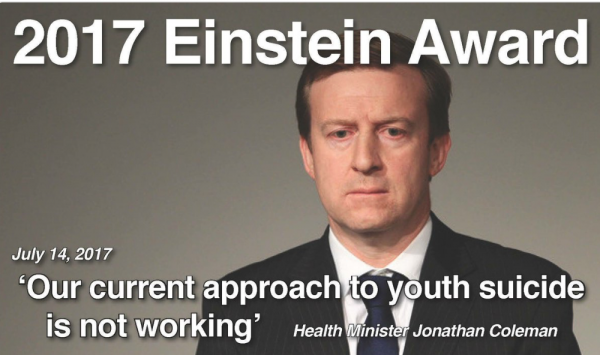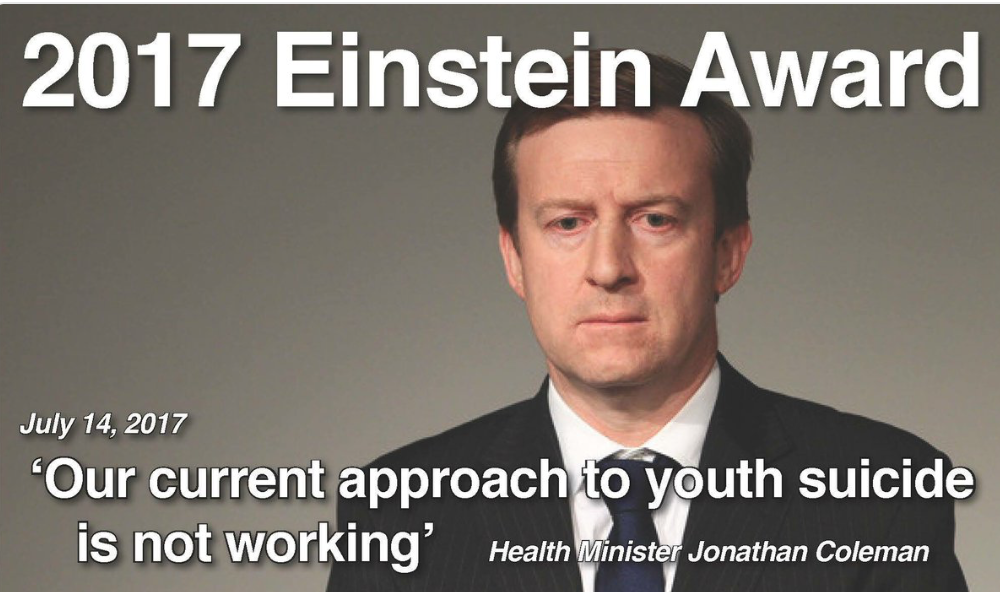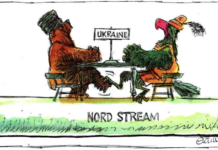
The attitude of Professor Annette Beautrais, of Canterbury University, and a suicide prevention co-ordinator for the South Canterbury DHB, is one of the primary reasons why it has been so hard to change the culture of silence about suicide, where news of it, and issues about it are swept under the carpet.
I cannot understand how, in this day and age, someone like Beautrais has been able to work for a DHB in this important field. At least she appears to have been severely questioned at Canterbury University [She is an adjunct professor at the University of Canterbury in Christchurch, where she formerly directed the Canterbury Suicide Project prior to leaving in 2009 because some of her grant applications for a research project and a suicide coordinator at Canterbury were rejected.[1][2] – Wikipedia], and presumably only retains her position there because of the antiquated ‘academic tenure’ system.
She also apparently holds several international positions, and appears to have made a living out of ‘suicidology’.
Less than two months ago Beautrais convinced three South Canterbury High Schools to withdraw invitations to suicide awareness promoter Mike King to speak to their students, one of the most stupid, retrograde steps I’ve heard of recently. She is a dangerous throwback to the times when the media were not allowed to mention suicide, and to when it did not appear in this country’s statistics – pre-2006 (not that far back).
New Zealand is making good strides towards a new culture of openness and inquiry about suicide and mental health. Families and individuals affected are speaking up, recounting their experiences and building support networks and organisations.
They have the direct experience of this issue; they are not academics earning a living from discussing it behind closed doors.
The former Chief Coroner, Neil MacLean, is campaigning for suicide and mental health issues to be brought more out into the open. He has heard hundreds of suicide cases; I’d trust his judgement more than I would an academic’s.
The country does not need the Annette Beautrais’ of the world poking their noses into the growing movement to tackle suicide in an open and honest way.
Retire Annette Beautrais, gracefully if possible, but either way, retire!
Dave Macpherson
Elected Waikato DHB Member
(Dave’s son Nicky Stevens was a suicide victim in March 2015)






Prof’ Beautrais was just another “stool pigeon for the shit medical fraternity overseeing the suicide epidemic.
She is a hired gun!!!!
The worst thing Beautrais has done is play a key role in killing off Yellow Ribbon, the peer-based suicide prevention initiative that was becoming adopted by many schools, because it risked ‘doing harm’ to vulnerable children! This when Yellow Ribbon was proving successful in getting children to ‘talk’ about self-harm to their peers and was clearly determined to base its approach on the ‘best science’. The Labour Government, specifically Jim Anderton, and Beautrais ‘official’ control of suicide prevention, rejected any challenge to their badly flawed ‘science’ and conspired to close it down.
“Who Killed Yellow Ribbon?
Yellow Ribbon was a self-help suicide prevention group founded by parents and friends of youth suicides who formed the Youth Suicide Awareness Trust in NZ 1997. Its basic approach was to enlist and train young people as ambassadors in schools to promote the Yellow Ribbon message that “It’s OK to ask for help”. Its members handed out yellow cards with the words “Its OK to ask for help” and referred young people who asked for help to health workers and counselors. Each school had a procedure for referral and for keeping their ambassadors safe from risk. Yellow Ribbon was initially modeled on the organization of the same name which was founded in the US in and which has since spread to many US states and to Australia, Canada, Scotland and Africa. By 2002 Yellow Ribbon NZ had over 1400 ambassadors in more than 140 schools.
Yellow Ribbon’s existence, however, was strongly contested. In NZ, Yellow Ribbon was consistently opposed by a number of academics and researchers in the field mainly associated with the New Zealand Youth Suicide Prevention Strategy, formed in 1998 after Yellow Ribbon, who argued that it could not prove that it did not ‘harm’ young people. Endorsements on the US Yellow Ribbon websites from suicidal young people who said they owed their lives to Yellow Ribbon and the many personal testimonies made to those involved in Yellow Ribbon in NZ did not fit with the orthodox “evidence based” approach to suicide prevention. Yet the case of a young Yellow Ribbon ambassador who committed suicide was cited informally as evidence of “harm”. The Minister in charge of NZYSPS, Jim Anderton, stated categorically:
“The literature is very clear – if you raise the profile of youth suicide, you get a higher rate of suicide”
(Collins).
As a result Yellow Ribbon had to look elsewhere for funding. When it went to ‘Fight or Life”, a charity boxing contest which featured “celebrity” matches, for funds it was heavily criticized for promoting a violent sport that could lead to bullying a recognized cause of suicide. Yet many of the ‘celebrities’ such as former league personality Tawera Nikau have a strong record in youth work. Another was the current Deputy Prime Minister, Bill English, who has yet to be shown up as a playground bully.
The question as to why Yellow Ribbon was closed down has yet to be answered. Those who were involved argue that it was deliberately shut down. They point to the claim made by the leading NZ suicide researcher Anne Beautrais who stated correctly that there was no evidence to prove “beyond doubt” that Yellow Ribbon did not cause harm.
In the face of this official criticism, Yellow Ribbon was more than ready to evaluate its approach to suicide prevention and correct any shortcomings. It commissioned Professor Ian Evans and Dr Narelle Dawson to design and implement a research project precisely for that purpose. This was the most advanced and robust study of Yellow Ribbon devised that I have seen anywhere. It was specifically designed to meet the requirement that: “the programme must demonstrate that it is “safe, effective, and evidence based, in a rigorous and scientific way.”
Thelma French wrote in response to Government concern that the Yellow Ribbon programme “lacked a robust evaluation framework”:
“Government is very aware of the evaluation design prepared by Prof Evans and Narelle Dawson in August 2002, the implementation of which we have been asked to delay, despite our seeking specific ring-fenced funding for evaluation studies. In order to ensure our evaluation plan would meet Ministry requirements, we initiated several meetings in which Yellow Ribbon requested from the Ministry representatives more detailed specification as to what in their view would be minimally required for a sound evaluation. To date they have been unable to provide any such guidelines. That safety issues have not been dismissed and are taken very seriously by Yellow Ribbon.”
However this was followed by a more serious criticism in a draft report of the IPRC at Auckland University:
“… the lack of evaluation evidence makes it extremely difficult to substantiate the impact of the program, and the level to which programme aims have been achieved. Consequently, respondents strongly questioned the probable contribution of the Yellow Ribbon program to young people’s help seeking behaviours and in particular to preventing suicidal behaviours among young people. Yellow Ribbon has no right whatsoever to claim that they make any positive contribution to suicide prevention.”
Yellow Ribbon replied:
“This type of comment places Yellow Ribbon in a classic double-bind. Obviously a programme cannot produce outcome evidence until it has been implemented for a period of time. Clearly the general thrust of the Yellow Ribbon programme is based on reasonable principles, and as already explained, work is under way to evaluate both process and outcome. Some initial efforts at review of processes have been initiated, for example in the above-mentioned questionnaire to ambassadors in January 2003, the majority (45.5%) said the training increased their knowledge a lot; and 27.5% said the training increased their knowledge somewhat.
The majority of ambassadors said training increased their knowledge of where to seek help a lot (40.9%) and 29.6% ambassadors said the training increased their knowledge somewhat. In addition Youthline has recorded a 500% increase in calls and relationship services have also seen a marked increase. Whenever asked if we believe we have contributed to the drop in youth suicide we state that our belief is that education and awareness is very important, but we always reiterate if there is a significant decrease, it is due to the efforts of many organisations and strategies.”
In fact, as the reference to the survey of ambassadors points out, despite claims to the contrary, Yellow Ribbon was responsibly cooperating in an evaluation by the Injury Prevention Research Centre at Auckland University to establish an ‘evidence base’. This survey found a large majority of the ambassadors strongly approving of, and supporting, the work of Yellow Ribbon. A small number expressed doubts about its value, but these were of not sufficient ‘concern’ to warrant being followed up by the research project. A larger minority thought there should be more professional backup and support.
However, as the researchers point out, most of those who responded (in fact a very low response rate of 37%) had been ambassadors for less than one year. This reflects the fact that Yellow Ribbon was by 2002 barely 3 years into its operation and was feeling its way and very willing to learn from the “evidence”. Moreover, the concerns of the researchers expressed in this report (lack of training, reported failure to refer young people at risk to adults or professionals etc) were clearly echoing the concerns of those ambassadors who wanted better training and more professional backup. Overall, the project endorsed Yellow Ribbon as a sound approach to youth suicide prevention.
However, the “concerns” that surfaced in the survey of Ambassadors were then used in the Ministry funded research on peer based programs as “evidence” that Yellow Ribbon’s program was “potentially harmful”. The results of this research were leaked to the Sunday Star Times which sensationalized YR as “dangerous”. Yellow Ribbon had its own evaluation of the research done by Professor Ian Evans and Dr Narelle Dawson, who found it to be “unscientific” and “unprofessional”.
The Evans/Dawson critique makes it clear that Yellow Ribbon is under attack by Government agencies. I would add that it was “unscientific” to misuse the survey of ambassadors based on a small sample in which an overwhelming endorsement of Yellow Ribbon by its ambassadors as cause for “potential harm” where suicides may results from promoting “awareness”, and Ambassadors put at risk in taking too much responsibility for counseling suicidal peers. It is clearly “unprofessional” in its cynical misrepresentation of Yellow Ribbon as lacking a theoretical base, and not interested in evaluating its methods, when it had initiated, designed and planned a world beating outstanding evaluation project and willingly collaborated with the University of Auckland Injury Prevention Research Centre to do the survey of its ambassadors.
While the survey of ambassadors was a world first in actually asking ambassadors (and not gatekeepers) to at least talk about their role, the obvious next step was not taken. Young people at risk were not asked if Yellow Ribbon had reduced their suicide attempts. Nor were those who did commit suicide tracked to see if their suicide was in any way caused by the “awareness” generated by the Yellow Ribbon program. Such critical questions were addressed by the Evans and Dawson evaluation plan. Moreover, the anecdotal evidence of testimonies of both ambassadors and young people helped by Yellow Ribbon and conveyed to the organizers was ignored as invalid and unreliable.
Yet, during the years of its existence from 1996 to 2005, suicide rates for the younger age groups (15-24) showed a decline of around a third. This was no doubt due to a combination of factors the most important of which is social inequality. But on the face of it, the “evidence” speaks for the efficacy of Yellow Ribbon rather than against it. So why did the IPRC researchers base their evaluation of Yellow Ribbon on the opinion of professionals (teachers and health workers) and not ask the young people who “talked” to the ambassadors, whether they thought suicide “awareness” prevented suicides or not? If Yellow Ribbon was at risk of doing “harm” why not ask the very people thought to be at risk? Why not fund the very good research project initiated by Yellow Ribbon that would have answered all these questions?
Read more at:
https://situationsvacant.wordpress.com/2009/04/29/talking-about-suicide/
I dunno. Experts here (I now live in Canada) also suspect suicide ideation is inserted into young people’s social discourse in a way that is new. On that, do you notice how often suicide is now a plot twist in modern t.v. series and cinema?
I accept it is difficult to disaggregate from socio economic factors.
[…] I strongly endorse Dave Macpherson’s call for Annette Beautrais to resign. https://thedailyblog.co.nz/2017/08/30/public-statement-on-call-by-prof-annette-beautrais-for-silence… […]
Comments are closed.